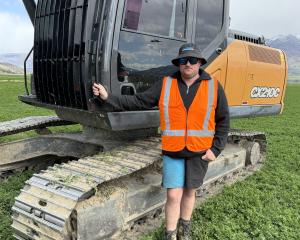
The Otago Daily Times has obtained a confidential letter sent to land owners in the Teviot Valley by Ken Smales, on behalf of the Clutha Pumped Hydro Consortium (CPHC).
The letter said Mr Smales had been engaged confidentially to find out if there was local landowner interest in a pumped hydro scheme now that the Ministry of Business, Innovation and Employment (MBIE) was no longer involved; CPHC was not expecting unanimous support, but if there was none it would drop the initiative.
Mr Smales, a former executive at Meridian Energy, confirmed he represented the consortium and it was a large project, but would not comment any further.
Waikato University Associate Prof Earl Bardsley came up with the pumped hydro battery project in 2002 and the idea had been passed round ever since.
Labour backed an investigation into the project in 2020 and spent $30million on analysis.
In 2020, the Labour government set up the NZ Battery Project, run by MBIE, to explore possible renewable energy storage solutions for when hydro lakes ran low for long periods. A pumped hydro scheme at Lake Onslow, above Millers Flat, was one of the options explored.
The idea was to pump water uphill during times of low power prices and store the water to be released in Lake Roxburgh when lake levels were low and electricity consumption high.
In December 2023, the National government stopped investigations into the project that was predicted by then to cost $16billion.
Announcing the axing of the scheme, then energy minister Simeon Brown said on top of its $16b price tag, the Lake Onslow scheme would run into likely issues with consenting and would not have delivered for at least another decade.
Beaumont Station, owned by Richard and Abby Hore, would be one of the most affected properties if a pumped hydro scheme went ahead.
Mr Hore said he was open to considering a proposal from the consortium but would not comment on whether he had been approached.
The previous government had wasted millions on its investigations and the Millers Flat community had been left upset by the way the project was conducted, he said.
His property was one of the biggest of six or eight properties affected by the proposed MBIE scheme.
"People walked all over our land and drilled holes. There was nothing for us, nothing for the valley."
Millers Flat needed a lift and new projects could provide that.
"There’s no cafe, no shop, the school [roll] is declining. The [Hawkeswood gold mine] has given it a boost."
Hopefully the new fast-track legislation would help get any proposed project under way quickly, Mr Hore said.
According to the letter from the consortium, three of its four directors had chaired or been chief executives of public companies in New Zealand and all were experienced in energy. All but one were born in Otago, and the fourth had spent a lot of their working life in the region.
They wanted to "deal well and generously" with landowners, offering them a shareholding in the enterprise if they wanted, the letter said.
The man who came up with the Lake Onslow battery project says it may be the only option left on the table.
Assoc Prof Bardsley said the reasons given for rejecting it two years ago were "a piece of spin".
The project was also intended to provide benefits for the southern half of New Zealand, which would overcome a "residual sense of grievance" that, despite doing so much for New Zealand, there was "little local benefit to the South".
He wondered where the backers would get the $16b to build the project, but it was in reality something the country needed, Assoc Prof Bardsley said.
"I can’t see Onslow not being built given the trouble we are getting ourselves into. We have no sites left on the Clutha and the Lower Waitaki. What water remains that we can get to power electricity? Especially now when it is all about emissions.
"After the experience of last year, we have to find a way to keep [electricity] prices down. You can’t grow the economy when you have expensive electricity."
Lake Onslow had the best storage and was in the right place. An investigation had looked at some land near Lake Taupo but it had been rejected, he said.
"There are all these mirages around various power schemes, nuclear fusion, other ideas, but we need to get serious about it.
"Long-term, the critical thing for the New Zealand economy is to have low-cost and reliable electricity, including through dry years. It is hard to see this being achieved without the Lake Onslow scheme."
One of the reasons to dump the scheme two years ago came from a "a piece of spin" by a generator which was seized on by the incoming National government, he said.
The scheme was said to have dampened down investment in generation projects. But he said it was actually the other way around. The Onslow scheme would operate by buying renewable energy and using that power to pump water from the Clutha River up to Lake Onslow. Some time later, the water was used to generate power. The only way this power could undercut renewable energy in the market would be if the Onslow scheme was operating as better than a perpetual motion machine.
"That is, all costs incurred from the pumping and generating inefficiencies were somehow set to zero and Onslow could sell its power for cheaper than the renewable energy it purchased in the first place."
It just could not operate like that. Evidence showed generation investment continued while the Onslow business study was being done, he said.











